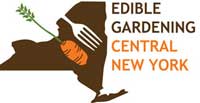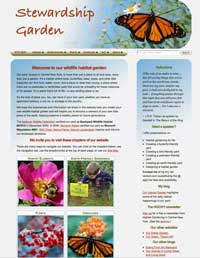| Syracuse Grows workshops |  |
What: Urban Garden Composting led by Greg Gelewski of OCRRA and Sarah Brown Where: Assisi Community Center and Isabella Street Tapestry Community Garden; 800 N Salina Street, Syracuse When: Wed. Aug.24, 5:30 - 7:30 pm
Who: Open to all gardeners, RSVP by email or call 424-9485 ext. 229 Details: Learn the basics of composting including aeration, proper moisture levels, carbon to nitrogen ratios and composting in Syracuse weather! The workshop will begin with a short presentation at the Assisi Center; then we will walk to the Isabella Street Tapestry Garden for a composting demonstration. Refreshments provided. Upcoming Workshops: Sustainable Strategies for Urban Gardens and Landscapes led by Terry L. Ettinger Wed., Aug. 31, 5:30-7:30 pm at the Westcott Community Garden (127 Harvard Pl., Syr.) Building Raised Garden Beds with a Raised Bed Building Demonstration by Les Ulm Wed., Sept. 14, 5:30-7:30 pm at the Southwest Community Farm (100 Bellevue Ave., Syr.)
|
Community Training in Ecological Design
Starts Sept. 10

Sponsored by Finger Lakes Permaculture Institute, The Alchemical Nursery, and Cornell Cooperative Extension
| |
Learn a land use design method to improve home scale food and forest production, conserve resources, and save money.
Study basic ecological principles and methods and use them to solve problems on your own home and landscape.
The class will meet once a week to discuss the principles and techniques of permaculture and ecology that help us make better choices for our land, families, and communities.
Class work will include a self-selected design project. You can design your own backyard, garden space, vacant lot, field, forest, or even an entire neighborhood.
Examples and applications will be presented in both an urban and rural context.
To enroll, contact any of the sponsoring organizations.
There are scholarships available. If you want to contribute to help fund scholarships, contact Frank Cetera.
|
| Interested in Edible Gardening? | 
|
If you'd like to get information on Edible Gardening CNY, just send an email to John to find out about edible gardening tours and programs.
|
|
Join HGCNY!
|  |
Becoming an official member of HGCNY is easy: just join Wild Ones! When you're a Wild Ones member, you're automatically an official member of HGCNY. |
|
Greetings!
Save the date for our annual plant sale!
The plant sale will be on Saturday, Sept. 10 at 10 am. Details are in the article below.
We need some volunteers to help return unsold plants. Contact John if you can help. Thanks!
Our last Show Me, Help Me Tour: Saturday August 27 in Jamesville - We will tour garden areas on a large rural property consisting of abandoned agricultural land and woods that have been harvested for timber over many years. RSVP to Randi, the host.
10:00 am: A long hike in the woods
11:30 am: A shorter garden tour near the house
Come to either or both.
And afterwards: You're invited to stay for a potluck picnic. Please bring your own table service, drink, chair, and a dish to pass.
 Meanwhile... Meanwhile...You can vicariously tour my own habitat garden by browsing my website Our Habitat Garden. You'll find lots of information about various creatures and how to provide habitat for them. Janet |
|
|
Guess the insect
 | A clue is the stripes on the body.
|
(Answer at the end of this email.)
|
|
HGCNY Plant sale:
Saturday Sept. 10, 10-noon
 | | Flowering spurge
(Euphorbia corollata)
Like baby's breath, but nicer!
|
Our annual HGCNY plant sale will take place at the Allens (directions). Plants not sold on Saturday will still be available for sale on Sunday, Sept. 11 from 1 - 3 pm.
Check out some of the possibilities
This year we'll have plants from five of our sponsors, together with plants provided by our own members. There should be a nice variety of plants, but if there's a particular plant you'd like, contact John, and we'll see if we can have them available.
You can see some of the plants we could have available by checking the Dan Segal's Plantsmen website or Ellen Folts' Amanda's Garden website.
Tree and shrub order
This year, we're beginning a new tree and shrub procedure from Jim Engel's White Oak Nursery. Instead of ordering trees and shrubs at the plant sale, please pre-order them by Saturday, September 3, and then you'll be able to pick them up at the plant sale (or at some later time if you're not able to get them on Sept. 10).
To see what shrubs and trees are available, go to the White Oak website. The cost will be $5 more than the price listed on the website to cover delivery costs and provide HGCNY with a modest profit (this is what lets us keep this newsletter and our programs free to the public!) Send your order to John. Pay when you pick up your trees and shrubs.
Please contribute your native plants
If you have extra native (native only, please!) plants in your garden please pot them up and bring them to the sale. Please identify your plants! People providing plants or working at the sale can begin to select plants at 9:00 A.M.
Volunteers needed to return unsold plants
We're looking for volunteers to return unsold plants. We're also looking for places (schools, community gardens, etc.) that would use any unsold member-donated plants.
~ John Allen and Randi Starmer,
Plant Sale Committee |
|
Another chance to get natives
Larry Keassa of Maple Hill Nursery, one of our sponsors, is a vendor at the Syracuse Regional Market on Saturday mornings.
He grows and sells native plants and will be bringing a large contingent of his native plants to the Regional Market on Saturday, September 18. He is in Shed A toward the north end of the building.
He has generously offered to donate part of the proceeds to HGCNY. Another of our members will be there from 10:00 A.M. to noon to answer questions about native plants and help in your selection.
(We could also use another volunteer to help staff the booth for a couple of hours. Email John if you can help. Thanks!) |
|
New lawn herbicide suspected in tree deaths
 | | Our pesticide-free lawn doesn't have many dandelions (we dig them out), but--HORRORS!-- it does have some clover (which helpfully fixes nitrogen to fertilize the lawn). At least, though, our lawn does NOT kill trees! |
Last year the E.P.A. approved the pesticide Imprelis, which was used to kill dandelions and clover in lawns. This year it has been implicated in the deaths of thousands of plants, such as white pine trees.
Fortunately, the pesticide had not yet been approved in New York State or in California, though it was registered in all other states.
Read more: New York Times, Rodale Gardening,
Consumer Reports |
When our concept of land ownership was generational, it must have seemed ordinary to plant a line of sapling sugar maples that someday one's grandchildren would tap for maple syrup.
Sugar maples planted along New England roads are well over a century old, some close to twice that age, but hardly anyone is planting young ones.
I think this is deeply wrong, or at least inordinately selfish. I know my land will pass into the hands of strangers; even so, I owe them its future. In our present and difficult transition to a wiser suburban landscape, we are all pioneers, preparing the ground for its future occupancy.
~ Sara Stein, from Planting Noah's Garden
(Sara Stein was an honorary director of Wild Ones) |
|
Permanently hotter summers
Scientists forecast permanently hotter summers for the future. "According to our projections, large areas of the globe are likely to warm up so quickly that, by the middle of this century, even the coolest summers will be hotter than the hottest summers of the past 50 years," said the study's lead author, Noah Diffenbaugh, a Stanford professor.
Read more ...
|
|
Guess the insect
 | Dragonfly laying eggs
|
Dragonflies are valuable predators that eat mosquitoes and other insects. They're beautiful, fascinating to watch, and great to have around! (And I have never met anyone whose mouth was sewn shut by a dragonfly or damselfly, despite what they told us as children...)
A backyard pond will help you attract dragonflies. The National Wildlife Federation has more information about how to attract dragonflies to your yard. However, you can also enjoy dragonflies by visiting wetlands.

The Stokes Beginners Guide to Dragonflies is a compact source of information, especially suitable for beginning and intermediate dragonfly/damselfly watchers. (This book is the source of the following information.)
Life stages
Damselflies and dragonflies have three life stages: egg, larva (also called nymph or naiad), and adult. The adults generally live only two to four weeks, but the nymphs may live from one month to five years, depending on species and conditions.
 | | Damselfly |
Dragonfly or damselfly? Here are some distinguishing characteristics.
Hindwings / forewings: Damselfly - similar in size; Dragonfly - hindwings broader than forewings Wing position when perched: Damselfly - wings pressed together or partly spread Dragonfly - wings held straight out to sides Overall appearance: Damselfly - smaller and more slender Eye position (in general): Damselfly - eyes separated Dragonfly - eyes meet in middle of head Flight style: Damselfly - weak fliers, stay close to ground Dragonfly - stronger, faster, fly out in the open |
|
|
|
|